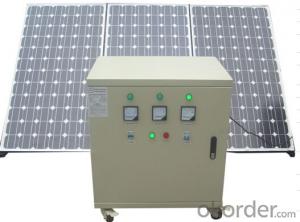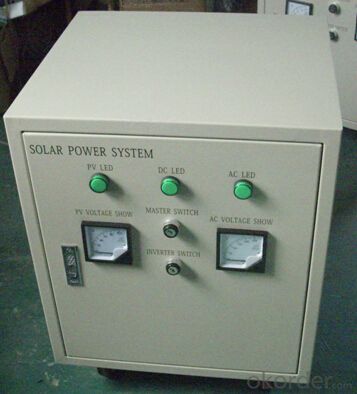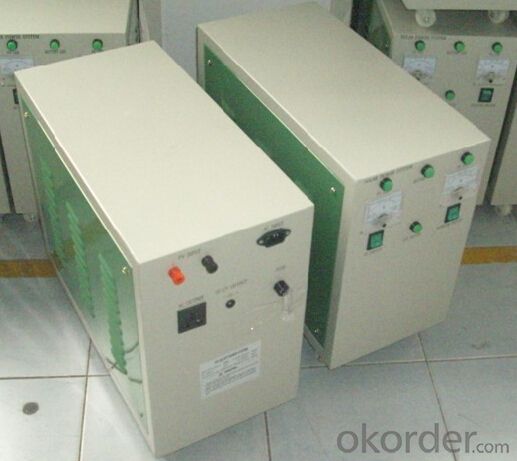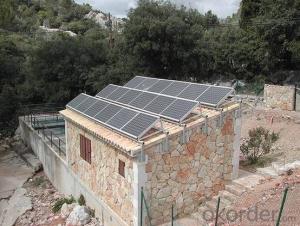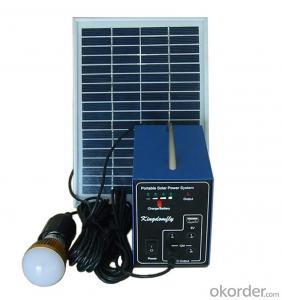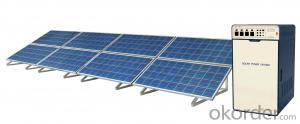CNBM Solar Home System Roof System Capacity-1000W
- Loading Port:
- Shanghai
- Payment Terms:
- TT or LC
- Min Order Qty:
- 5 pc
- Supply Capability:
- 30000 pc/month
OKorder Service Pledge
OKorder Financial Service
You Might Also Like
Introduction of Solar Home System
Solar Home System is composed by Solar Panels, Inverters, Charger Controller, Battery, Cable, Mounting Bracket, which is applied to produce electricity for home use.
Solar Home System is quite suitable product in urban area and the place which is short of electricity. Our Small Solar Home System own great benifits compare with other kind electricity resources:
Electricity generating cost of Solar Home System is much cheaper than diesel engine. Beside low electricity making cost, solar system products also have the features of noiseless, clean energy, environmentally friendly and can access to many different electric appliance.
Picture of Our Factory

Working Principle of Solar Home System
The stand alone Solar Home System is an off-grid solar system which uses batteries to store the solar energy. Stand alone solar system solutions design for those who are not able or willing to connect to electricity grid.
However, our on-grid solar home system can be connected to the grid for utilization of grid electricity power. Our solar system can add relative equipment as our customer’s requirement which have the function of switching to city electricity automatically. The solar system can use battery power in priority, if sunshine is not so good or loads consumption is too high which cause battery power insufficient. Then system can switch automatically to grid power supply. Meanwhile, the system can charge the batteries with grid power until batteries are fully charged. Then the solar system will switch back to battery power supply.
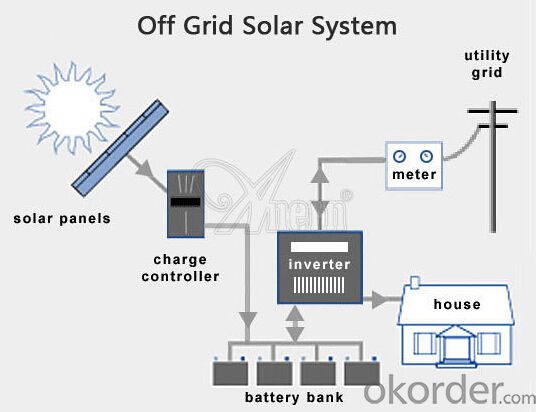
Product Details of Solar Home System
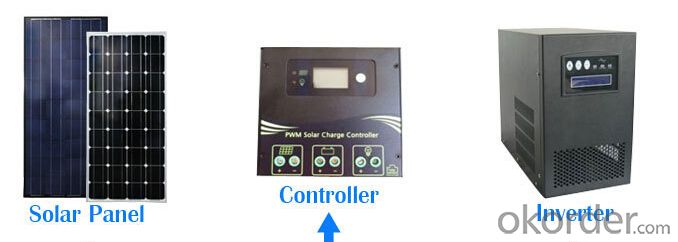
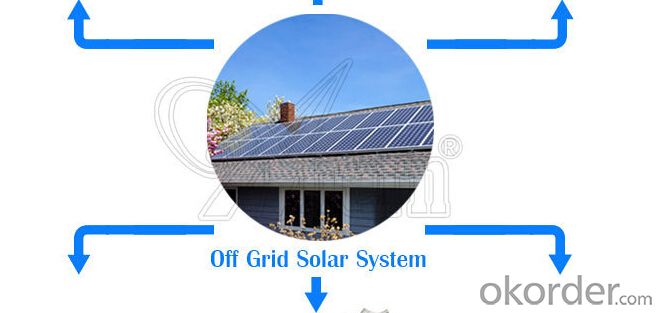

Specification of Solar Home System
Technical data: | ||||||||
Inverter | Rated load power | 1500W | ||||||
Output wave | Pure sine wave | |||||||
Input voltage | 24V | |||||||
Output voltage | DC:12V | |||||||
Output frequency | 50HZ/60HZ | |||||||
Precision of output frequency | ±6% | |||||||
Solar panel | Pmax | 167W*6PCS | ||||||
Vmp | 36V | |||||||
Imp | 27.8A | |||||||
Charger | Charger voltage & current | 24V/20A*3 | ||||||
Battery | Capacity | 12V/150AH*4PCS | ||||||
Power box | Spray paint iron box,with input,output, ammeter,voltmeter,master switch and so on. | |||||||
Package data: | ||||||||
Part | Size (L*W*H mm) | Weight (kg) | 20' (pcs) | 40' (pcs) | ||||
Power box | 580*520*540 | 60 | 96Sets | 240Sets | ||||
Solar panel | 1600*830*90 | 90 | ||||||
Battery | 540*520*350 | 220 | ||||||
Loading electrical equipment(For Consulting) | ||||||||
Name of Load | Power(W) | Quantity | Working Time per Day (H) | Working Days | ||||
Color TV | 65W | 1 | 6 | 3 days | ||||
Satellite TV Receivers | 25W | 1 | 6 | 3 days | ||||
lamp | 11W | 8 | 8 | 3 days | ||||
Computer | 150W | 2 | 6 | 3 days | ||||
FAN | 60W | 2 | 6 | 3 days | ||||
Other | 100W | 1 | 4 | 3 days | ||||
Advantage of Our Solar Home System
1 Excellent Performance: Our Solar Home System is composed by Brand Standard Kits with high quality. Our solar system has the advantage of high efficiency and stable operation. We can ensure our product with a long life period.
2. Small Orders Accepted: We can accept small orders as our customer’s trial order.
3. Warehouse: We have warehouse overseas which can bring great convenience to our customer to pick up the products.
FAQ
Q: Could you introduce the background of your company?
A: We are a Group corp. with 1GW capacity in China, which is Okorder’s registered VIP Supplier, possess Financial Service from Okorder.com.
Q: Required mainly certificates (CE&IEC/TUV/RoHS)?
A: Our products are certificated by CE RoHS, IEC, ISO, TUV, UL etc.
Q: Your main exported market is?
A: Main markets of our products is: South-east Asia, Mid-east, Arica, East Europe and Latin America.
- Q:Are there any limitations to the amount of electricity a solar energy system can generate?
- Yes, there are limitations to the amount of electricity a solar energy system can generate. The primary limitation is the availability of sunlight. Solar panels require direct sunlight to generate electricity, so factors such as weather conditions, geographical location, and time of day can affect the amount of sunlight received. Cloudy or rainy days can significantly reduce the electricity output of a solar energy system. Another limitation is the physical space available for installing solar panels. The size and number of panels that can be installed depend on the available roof or ground space. Limited space can restrict the overall capacity of the system and, consequently, the amount of electricity it can generate. Additionally, the efficiency of solar panels is a determining factor. The efficiency of converting sunlight into electricity varies depending on the type and quality of solar panels used. Higher efficiency panels can generate more electricity than lower efficiency ones. Furthermore, solar energy systems are also subject to degradation over time. Solar panels experience a gradual decrease in efficiency as they age due to factors like exposure to sunlight, temperature fluctuations, and environmental conditions. This degradation can reduce the overall electricity generation capacity of the system. Finally, energy storage is a limitation. Solar energy systems generate electricity during the day, but the demand for electricity often remains constant throughout the day and night. Without an efficient energy storage system, excess electricity generated during the day is wasted if not used immediately. Therefore, the inability to store excess electricity limits the overall amount that can be generated by a solar energy system. In summary, while solar energy systems offer a sustainable and renewable source of electricity, there are limitations to the amount they can generate due to factors such as sunlight availability, physical space, panel efficiency, system degradation, and energy storage capabilities.
- Q:Can solar energy systems be used in areas with limited access to solar monitoring systems?
- Yes, solar energy systems can be used in areas with limited access to solar monitoring systems. While solar monitoring systems help optimize the performance and efficiency of solar energy systems by providing real-time data on solar radiation, energy production, and system health, they are not essential for the functioning of solar energy systems. Solar panels can still generate electricity in areas with limited monitoring systems, as long as they receive sufficient sunlight. While the absence of monitoring systems may limit the ability to track and troubleshoot system performance remotely, solar energy systems can still be installed and operated effectively in such areas.
- Q:Are there any financing options available for solar energy systems?
- Yes, there are several financing options available for solar energy systems. These options include solar loans, solar leases, power purchase agreements (PPAs), and government incentives such as tax credits and grants. These financing options help make solar energy more accessible and affordable for homeowners and businesses.
- Q:Can solar energy systems be used for powering industrial processes?
- Certainly, industrial processes can be powered by solar energy systems. In recent years, solar power has gained popularity as a sustainable and renewable energy source. The energy demands of industrial processes are often substantial, and solar power can be harnessed to meet these requirements. There are various ways in which solar energy systems can be utilized for industrial processes. One common approach involves installing solar photovoltaic (PV) panels. These panels convert sunlight directly into electricity, which can then be used to power industrial machinery and equipment. By integrating solar PV systems into existing infrastructure, industries can reduce their reliance on traditional fossil fuels and decrease their carbon footprint. In addition to generating electricity, solar thermal systems can also be employed to power industrial processes. Solar thermal technology uses the sun's heat to produce steam, which can then drive turbines or provide direct heat for industrial applications. This method is particularly beneficial for industries that require high-temperature processes, such as manufacturing, chemical production, or food processing. Implementing solar energy systems for industrial processes offers numerous advantages. Firstly, it helps to mitigate greenhouse gas emissions and combat climate change. Solar power is a clean energy source that emits no harmful pollutants or greenhouse gases during operation. By transitioning to solar energy, industries can contribute to a more sustainable and environmentally friendly future. Furthermore, utilizing solar power can lead to long-term energy cost savings for industries. Although the initial investment for installing solar energy systems may be significant, the operational costs are considerably lower compared to traditional energy sources. Once the systems are in place, industries can benefit from reduced electricity bills and even generate excess energy that can be sold back to the grid. Lastly, solar energy systems provide a reliable and resilient power source. They can function even in remote areas or during power outages, ensuring uninterrupted production processes. Additionally, solar panels have a long lifespan and require minimal maintenance, making them a viable long-term solution for industrial power needs. In conclusion, solar energy systems can indeed be utilized for powering industrial processes. With advancements in solar technology and an increasing emphasis on sustainability, more and more industries are embracing solar power to meet their energy demands. By harnessing the sun's energy, industries can reduce their environmental impact, save on energy costs, and ensure a reliable and resilient power supply for their industrial processes.
- Q:What is the impact of air pollution on the performance of solar panels?
- Air pollution can have a significant impact on the performance of solar panels. One of the main ways it affects solar panel performance is by reducing the amount of sunlight that reaches the panels. Air pollution, such as smog and particulate matter, can scatter and absorb sunlight, resulting in a decrease in the amount of solar energy that can be absorbed by solar panels. This reduces the overall efficiency and power output of the panels. Additionally, air pollution can deposit a layer of dust, dirt, and other pollutants on the surface of solar panels. This layer can block and absorb sunlight, further reducing the amount of energy that can be harvested. The accumulation of these pollutants also creates a barrier that hinders the transmission of sunlight to the solar cells, further decreasing the efficiency of the panels. Furthermore, air pollution can lead to the corrosion of the surfaces of solar panels. Pollutants, such as sulfur dioxide and nitrogen oxides, can react with moisture in the air to form acidic compounds. These compounds can gradually degrade the protective coatings on the panels and cause damage to the cells, reducing their performance and lifespan. Overall, the impact of air pollution on the performance of solar panels is significant. It decreases the amount of sunlight that can be harvested, reduces the efficiency and power output of the panels, and can lead to damage and degradation of the panels over time. Therefore, it is crucial to consider the effects of air pollution when designing and installing solar panels to ensure optimal performance and longevity.
- Q:Can solar energy systems be combined with energy storage technologies like batteries?
- Yes, solar energy systems can be combined with energy storage technologies like batteries. This combination allows for the storage of excess solar energy generated during the day, which can be used during times when the solar panels are not producing enough energy, such as at night or during cloudy weather. Energy storage technologies like batteries help in optimizing the use of solar energy and ensure a more consistent and reliable power supply.
- Q:How does net metering work with solar energy systems?
- Net metering is a billing arrangement that allows solar energy system owners to receive credits or compensation for the excess electricity they generate and feed back into the grid. When a solar energy system produces more electricity than is being consumed on-site, the surplus power is sent back to the utility grid. In return, the utility company credits the system owner's account for the excess electricity, which can be used to offset future electricity consumption from the grid, effectively "spinning the meter backward." This arrangement enables solar energy system owners to save money on their utility bills and encourages the adoption of renewable energy by providing financial incentives.
- Q:Can a solar energy system be installed on a roof?
- Installing a solar energy system on a roof is indeed possible. In fact, rooftop solar installations are widely prevalent and favored. Homeowners and businesses can tap into the sun's energy by placing solar panels on their roofs, thus generating clean and renewable power. This not only leads to lower electricity bills but also reduces dependence on fossil fuels, fostering a more sustainable future. Roof-mounted solar installations are typically designed to maximize sunlight exposure and can be implemented on different roof types, including flat and sloped roofs. Thanks to technological advancements and the availability of various mounting options, solar panels can be securely and efficiently installed on both residential and commercial roofs.
- Q:Can solar panels be installed on floating platforms or buoys in bodies of water?
- Yes, solar panels can be installed on floating platforms or buoys in bodies of water. This concept, known as floating solar or floating photovoltaic (FPV), is gaining popularity as it offers several advantages such as utilizing underutilized water surfaces, reducing evaporation, and increasing energy generation due to the cooling effect of water. It also minimizes land use conflicts and can be deployed in various bodies of water including lakes, reservoirs, and even oceans.
- Q:Can solar energy systems be used in powering amusement arcades or gaming centers?
- Yes, solar energy systems can be used to power amusement arcades or gaming centers. Solar panels can be installed on the roof or in nearby open spaces to harness sunlight and convert it into electricity. This renewable energy can then be used to power the electrical equipment, lighting, and other energy-consuming devices within the amusement arcade or gaming center. Implementing solar energy systems not only reduces reliance on traditional energy sources but also saves costs in the long run and promotes sustainable practices.
1. Manufacturer Overview |
|
|---|---|
| Location | |
| Year Established | |
| Annual Output Value | |
| Main Markets | |
| Company Certifications | |
2. Manufacturer Certificates |
|
|---|---|
| a) Certification Name | |
| Range | |
| Reference | |
| Validity Period | |
3. Manufacturer Capability |
|
|---|---|
| a)Trade Capacity | |
| Nearest Port | |
| Export Percentage | |
| No.of Employees in Trade Department | |
| Language Spoken: | |
| b)Factory Information | |
| Factory Size: | |
| No. of Production Lines | |
| Contract Manufacturing | |
| Product Price Range | |
Send your message to us
CNBM Solar Home System Roof System Capacity-1000W
- Loading Port:
- Shanghai
- Payment Terms:
- TT or LC
- Min Order Qty:
- 5 pc
- Supply Capability:
- 30000 pc/month
OKorder Service Pledge
OKorder Financial Service
Similar products
New products
Hot products
Hot Searches
Related keywords
